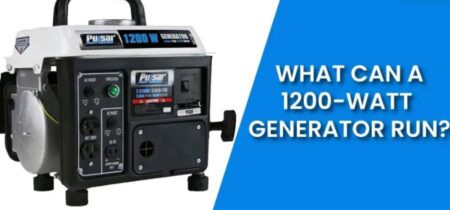
A generator can be a lifesaver during power outages or when you’re in a remote location without access to electricity. However, if you’ve noticed your generator blowing white smoke, it can be a cause for concern. In this blog, we’ll explore the possible reasons why is my generator blowing white smoke and what you can do to fix it.
Why is My Generator Blowing White Smoke
- Coolant Leak
If the coolant is leaking into the combustion chamber, it can cause white smoke to come out of the exhaust. This is because the coolant burns with the fuel and air, creating a white vapor. If you suspect a coolant leak, it’s essential to stop using the generator immediately and have it inspected by a professional.
- Clogged Air Filter
When the air filter becomes dirty or clogged, it can restrict the air supply to the engine, causing incomplete combustion and white smoke. To fix this issue, you can clean or replace the air filter, depending on the level of clogging.
- A Malfunctioning Fuel System
It can also cause white smoke to blow into your generator. If the fuel injectors or carburettor are dirty or clogged, it can cause incomplete combustion and white smoke. It’s recommended to clean the fuel system regularly and replace the fuel filters to avoid such issues.
- Use of the Wrong Type of Fuel
If you use fuel with a lower octane rating than recommended, it can cause incomplete combustion and produce white smoke. Always ensure you’re using the correct type of fuel as recommended by the manufacturer.
- Water in a Fuel Tank
One of the possible reasons why a generator may be blowing white smoke is the presence of water in the fuel tank. Water can find its way into the fuel tank through condensation or other means, and if it accumulates, it can cause several issues. When the generator tries to burn the fuel, the water in the tank will vaporize and mix with the fuel, leading to incomplete combustion.
This incomplete combustion can cause the generator to emit white smoke as the unburnt fuel and water vapor is expelled through the exhaust system. If left untreated, water in the fuel tank can also cause rust and corrosion, leading to further damage to the generator’s engine. It is important to check the fuel tank regularly for signs of water and drain any accumulated water from the tank as part of routine generator maintenance.
- Worn or Damaged Piston Rings
Piston rings are designed to create a seal between the piston and the cylinder walls, preventing the combustion gasses from escaping into the crankcase. Over time, piston rings can wear down, crack, or become damaged, which can cause the oil to leak into the combustion chamber. When oil mixes with fuel and burns, it creates white smoke.
Additionally, worn or damaged piston rings can cause a loss of compression, which can affect the generator’s performance and cause it to emit white smoke. If you suspect that worn or damaged piston rings are the cause of your generator blowing white smoke, it is essential to seek the assistance of a qualified technician for repairs. Regular maintenance, such as changing the oil and air filters, can help prolong the life of the piston rings and prevent premature wear or damage.
If you’re experiencing these issues, it’s essential to stop using the generator and have it inspected by a professional. Regular maintenance and following the manufacturer’s recommendations can help prevent such problems from occurring in the first place.
What is a Parallel Operation of Generators?
Parallel operation of generators refers to the process of combining two or more generators to produce a larger power output. This technique is commonly used in situations where a single generator is insufficient to meet the required power demand, such as in industrial, commercial, or residential applications. By paralleling generators, the overall power output can be increased, providing a reliable and stable power supply.
Conditions for Parallel Operation of Generators
To ensure the safe and efficient parallel operation of generators, certain conditions must be met.
- Identical Voltage, Frequency, and Phase
The first and most important condition for the parallel operation of generators is that they must have the same voltage, frequency, and phase. The generators must be synchronized with each other to prevent electrical imbalances that could damage the equipment or pose a safety hazard. To synchronize the generators, a synchronization panel is used, which detects and adjusts the voltage, frequency, and phase of the generators to match each other.
- Identical Load-Sharing Capability
The load-sharing capability of the generators must be identical, meaning that they should be able to share the load equally. Load-sharing ensures that each generator operates within its optimal range, preventing overloading or underloading of the generators. The load-sharing capability is achieved by using a load-sharing control panel, which distributes the load between the generators based on their capacity.
- Suitable Governor Response
The governor response of the generators must be suitable for parallel operation. The governor is responsible for controlling the speed and power output of the generator, and it must respond quickly to load changes to maintain a stable power supply. A suitable governor response ensures that the generators can respond to sudden changes in load demand, preventing fluctuations in voltage or frequency.
- Similar Generator Characteristics
The generators used for parallel operation must have similar characteristics, such as capacity, type, and age. Mixing generators with different capacities, types, or ages can cause imbalances in the load sharing, resulting in overloading or underloading of the generators. Additionally, mixing generators with different types, such as diesel and gas generators, can result in fuel incompatibility issues, causing damage to the engines or fuel systems.
- Proper Electrical Protection
The generators used for parallel operation must have proper electrical protection, such as overcurrent protection, short circuit protection, and ground fault protection. Electrical protection devices are used to prevent damage to the equipment and electrical circuits in case of a fault or malfunction.
- Suitable Power Factor
The power factor of the generators must be suitable for parallel operation. The power factor is a measure of the electrical efficiency of the generator, and it determines the ratio of the real power to the apparent power. A suitable power factor ensures that the generators can supply the required power efficiently, preventing voltage drops or fluctuations.
- Proper Cooling System
The cooling system of the generators must be suitable for parallel operation. The generators must be able to dissipate heat efficiently to prevent overheating and damage to the engines. A suitable cooling system ensures that the generators can operate at their optimal temperature range, preventing premature wear and tear of the components.
Can You Parallel Two Regular Generators?
Yes, it’s possible to parallel two regular generators, but it requires some additional equipment and caution. The primary purpose of parallel generators is to increase the overall power output and provide backup power during an outage. However, the generators must have identical power outputs, voltage, and frequency to operate efficiently in parallel.
To connect two generators in parallel, you will need a parallel kit or an automatic transfer switch that is designed specifically for this purpose. The parallel kit includes cables and a special control panel that allows you to connect the generators and control the power output.
It’s important to note that connecting generators in parallel can be dangerous if not done correctly. You need to ensure that the generators are synchronized and operating at the same frequency to prevent damage to the equipment or electrical circuits. Overloading one generator can also cause it to fail or damage the connected appliances.
Additionally, you should never attempt to connect different types of generators or generators with different power outputs in parallel. Doing so can cause severe damage to the equipment and pose a significant safety hazard.
Can you parallel an inverter generator?
Yes, inverter generators can be paralleled, and they offer several advantages over regular generators. Inverter generators are designed to produce clean and stable power, making them suitable for powering sensitive electronic devices. By paralleling two or more inverter generators, you can increase the overall power output and provide backup power during an outage.
Paralleling inverter generators is relatively straightforward, and it does not require any additional equipment. Most inverter generators come with a built-in parallel capability, allowing you to connect them using a parallel cable. The cable connects the two generators’ parallel outlets, and the control panel automatically synchronizes the generators’ frequency and voltage.
It’s important to note that you should only parallel inverter generators of the same model and capacity. Connecting different models or sizes of generators can cause damage to the equipment or pose a safety hazard. Additionally, you should avoid overloading the generators beyond their capacity, as it can cause them to fail or damage the connected appliances.
Hence, inverter generators can be paralleled, and it’s a great way to increase the overall power output and provide backup power during an outage. However, it’s essential to use identical generators and avoid overloading them to prevent damage to the equipment or electrical circuits. Always follow the manufacturer’s instructions and guidelines to ensure safe and efficient operation.
Conclusion
In conclusion, there are several reasons why a generator may be blowing white smoke, including a clogged air filter, water in the fuel tank, worn or damaged piston rings, and a malfunctioning carburetor. It is important to identify the root cause of the issue to prevent further damage to the generator and ensure its safe and effective operation. Regular maintenance, such as checking and replacing air and fuel filters and draining water from the fuel tank, can help prevent these issues from occurring. If the issue persists or is beyond your ability to fix, it is recommended to seek the assistance of a qualified technician.
Also Read:
How to Connect a Generator to a House Without Transfer Switch








